

Mar 16:15,16 And he said unto them, Go ye into all the world, and preach the gospel to every creature. He that believeth and is baptized shall be saved; but he that believeth not shall be damned.
What follows is a brief but untold tale of the spread of pure Evangelistic Christianity across Catholic Europe and into England from the fourth century onwards:
IMPORTANT:
This web site does not propose a succession of churches of Christ from the earliest days to today. The true church can be established anywhere, at anytime, by any person when the seed is planted (Matthew 13). What this web site does show that to understand the Bible, Martin Luther, Jean Chauvin (Calvin), Jacobus Arminius and others, being 1500 years too late, are not needed and mislead with their ideas of grace and total depravity!
There is ample evidence the church existed in the Middle and earlier Dark Ages, despite some denying the truth on this matter. Reformation leads to a simple, earlier form of Catholicism, minus many extravagant excesses.
Restoration and Reformation must not be confused. Restoration leads back to the pure, Jerusalem gospel. Reformation leads back to Rome and the Roman gospel which was three hundred years too late, being based on the pagan system of total depravity (original sin), fatalism and salvation through good works, replaced by the Reformers by salvation through 'Grace' and Faith Only!
An obedient faith will lead to both good works and receiving grace. All are needed together.
John Cassian, was a monk and spiritual writer who lived c. 360-435. He was possibly oriental by birth. Cassian lived during the time of Augustine and strongly opposed his views. Cassian established two monasteries at Marseilles, southern France, one for men and the other for women, about 415. Around the year 428 opposition to both the Augustinan and Pelagian views was being voiced by Cassian. Cassian at this time resided at his monastery at Marseilles. The teachings of Cassian and his followers spread throughout the south of France. Regarded by some as sectarians, there is no evidence that they separated from the church of that time.
What is interesting about Cassian and his followers is their opposition to the teachings of Augustine, and that this opposition continued for some time. It is also clear from his writings that the teachings of Augustine and Pelagius were recent in origin.
Modern historians have accused Cassian of being semi-pelagian in doctrine, but this is a recent invention and was not a term used in his time.
They taught that salvation through Christ was available to all that ask, through free will choice. Therefore they have rejected teachings on original sin and predestination. Cassian in his writings refers back to the early church fathers and Scriptures as a defence of his position. The western church opposed these teachings but they found favour with the eastern church. These doctrines continued openly in the western church until the sixth century when they were outright condemned by the Council of Orange, 529.
In 422 the Catholic Bishop Germanus complained of the British church that it practised believers baptism and rejected the authority of the pope and other Catholic doctrines. The Edict of pope Innocent 1 had made infant baptism (by immersion) compulsory in 407.
Worship and prayer in the Catholic church were used in Latin as opposed to the vernacular from around 600, which helped in the separation of the laity from the clergy.
From around the late 500s starting in the east a sect of Christians who were called Paulicians, because of their ability to defend their doctrine from the New Testament, particularly from the letters of the apostle Paul came to the notice of the authorities. They said that they were Christians who were chosen of God and called each other brother or sister. They had rejected the infant baptism of the Catholic church teaching that faith is required before baptism.
It would seem on examination that these were Christians holding to the pattern of the New Testament. They are also known elsewhere as Publicans particularly in England (Publicani from Paulikanoi from Paulicians). Their teachings quickly spread throughout Europe. The Irish/Scottish church of this time still practised believers baptism and generally rejected Roman Catholic teaching. It can be assumed that contact was made as the Celtic church at this time was working effectively in Europe. After severe persecution the Paulicians ended up in Bulgaria and other Balkan countries and there they assisted the French church during its persecution in the twelfth century when they became known as the Bougre (in middle English Bugger). We can establish with some certainty that New Testament Christianity was being propagated through out Europe and the east by the end of the eighth century.
In the year 141, in the east of Britain, in what is now Cambridgeshire, in the village of Grauta (modern Grantchester), “many were baptized.” Grantchester a small village a few minutes from Cambridge. Below, the river Cam (from which Cambridge is named) at Grantchester, where believers' baptism could have taken place nearly nineteen hundred years ago.

Below, Richborough is perhaps the most symbolically important of all Roman sites in Britain. Rutupić was the Roman name for Richborough, a castle, near Sandwich, Kent, which the Romans founded after they landed in England in AD 43. It has an open air baptismal font for adult immersion. It has confused both historians and archaeologists who would expect such a font to be in a 'church' building, but this one has no sign of ever having been close to a building, the font ha been dated to the fourth century.

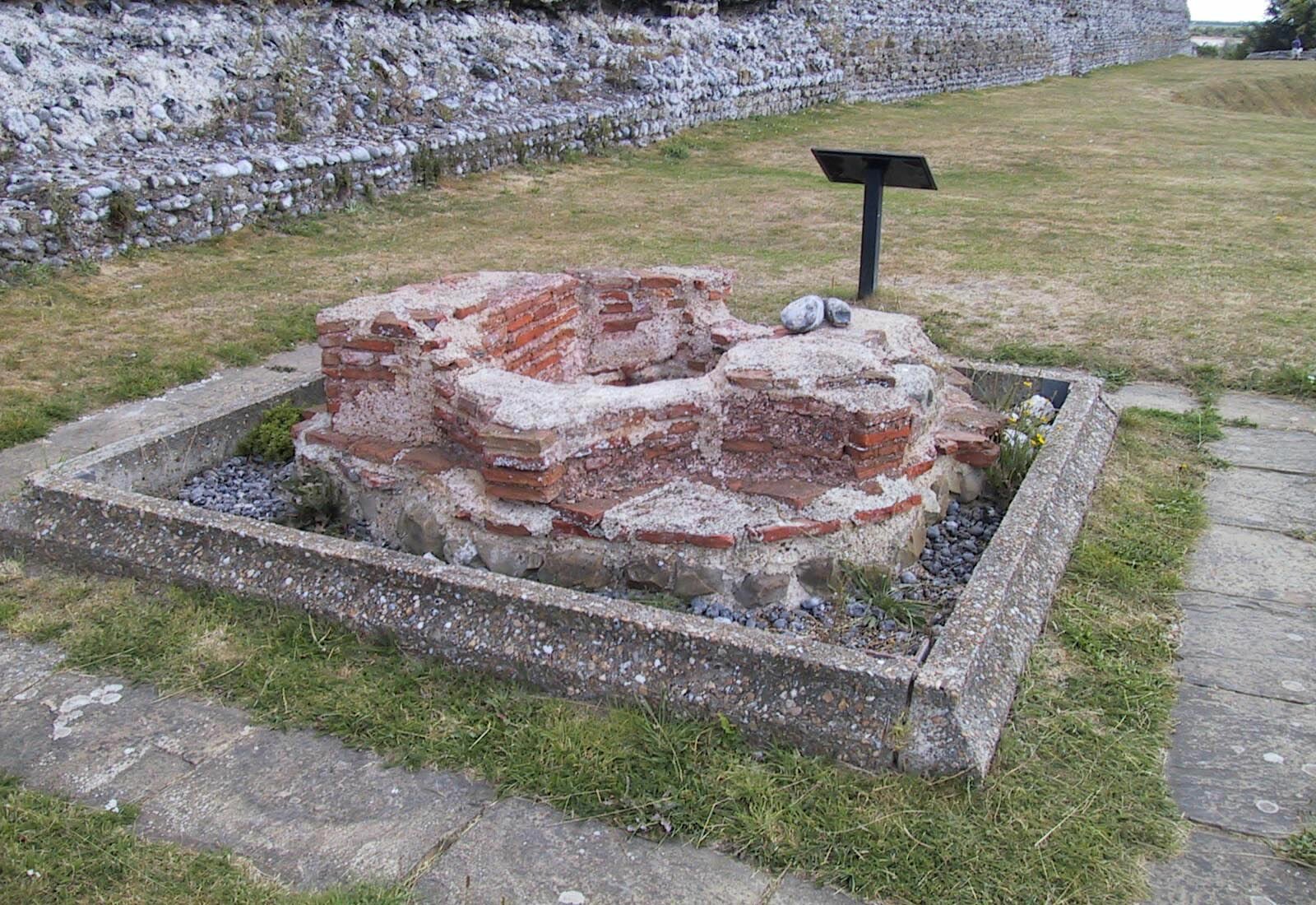
Below, St Myllin’s well in Llanfyllin is dedicated to St Myllin, who lived in the area in the 6th century who baptised believers by total immersion. The well was originally about 6 feet square but was rebuilt in 1987 and has changed considerably. Myllin would have been a preacher for the ancient British church and would not have been given the title of 'saint' for many centuries. It is a reminder that beleivers' baptism by immersion was normal until the Roman Catholics by force took over the ancient church introducing infant baptism. The sign is incorrect when it states Myllin was the first to "baptise by immersion", it had been the practise of the ancient church from is start.
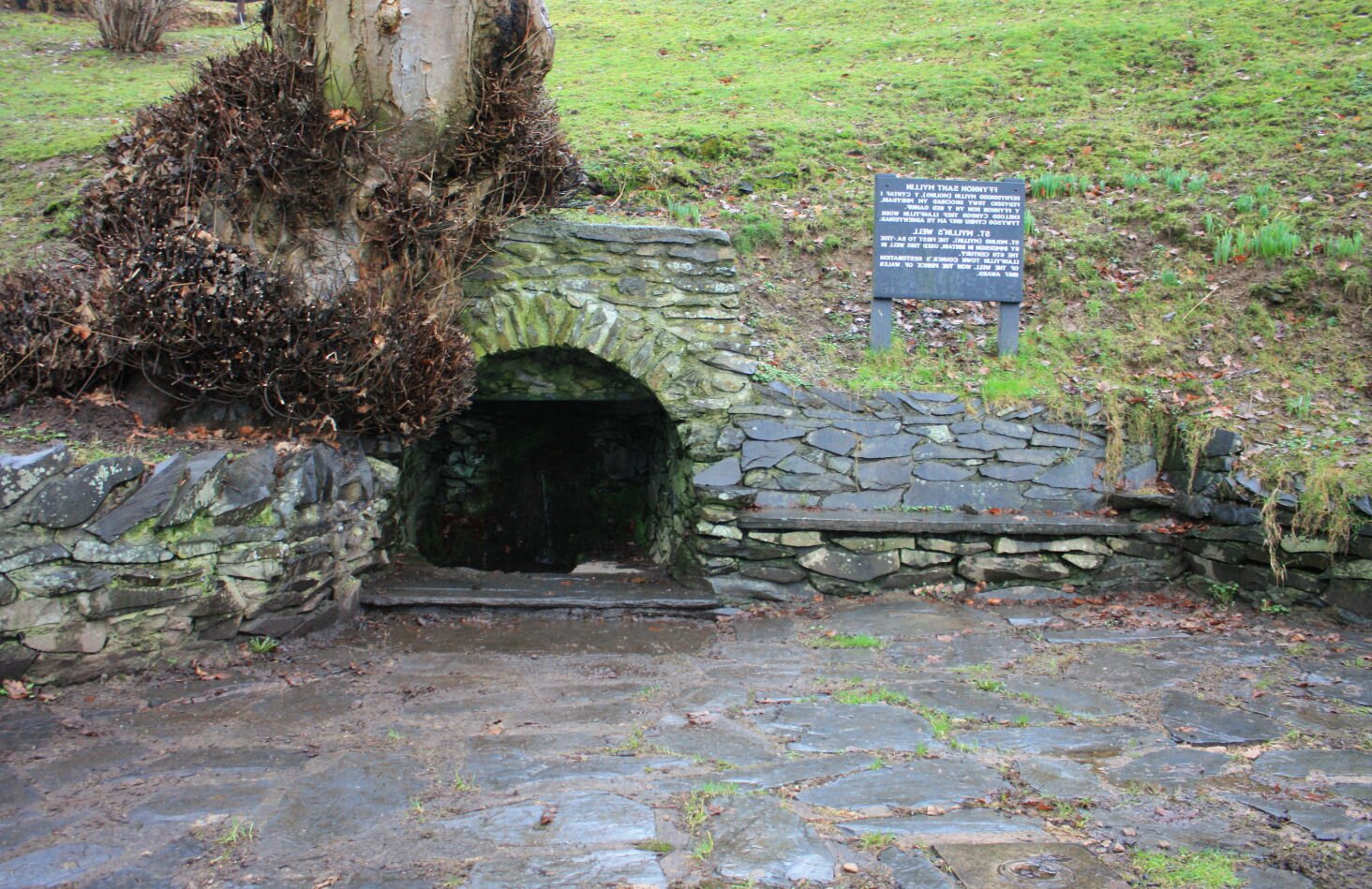
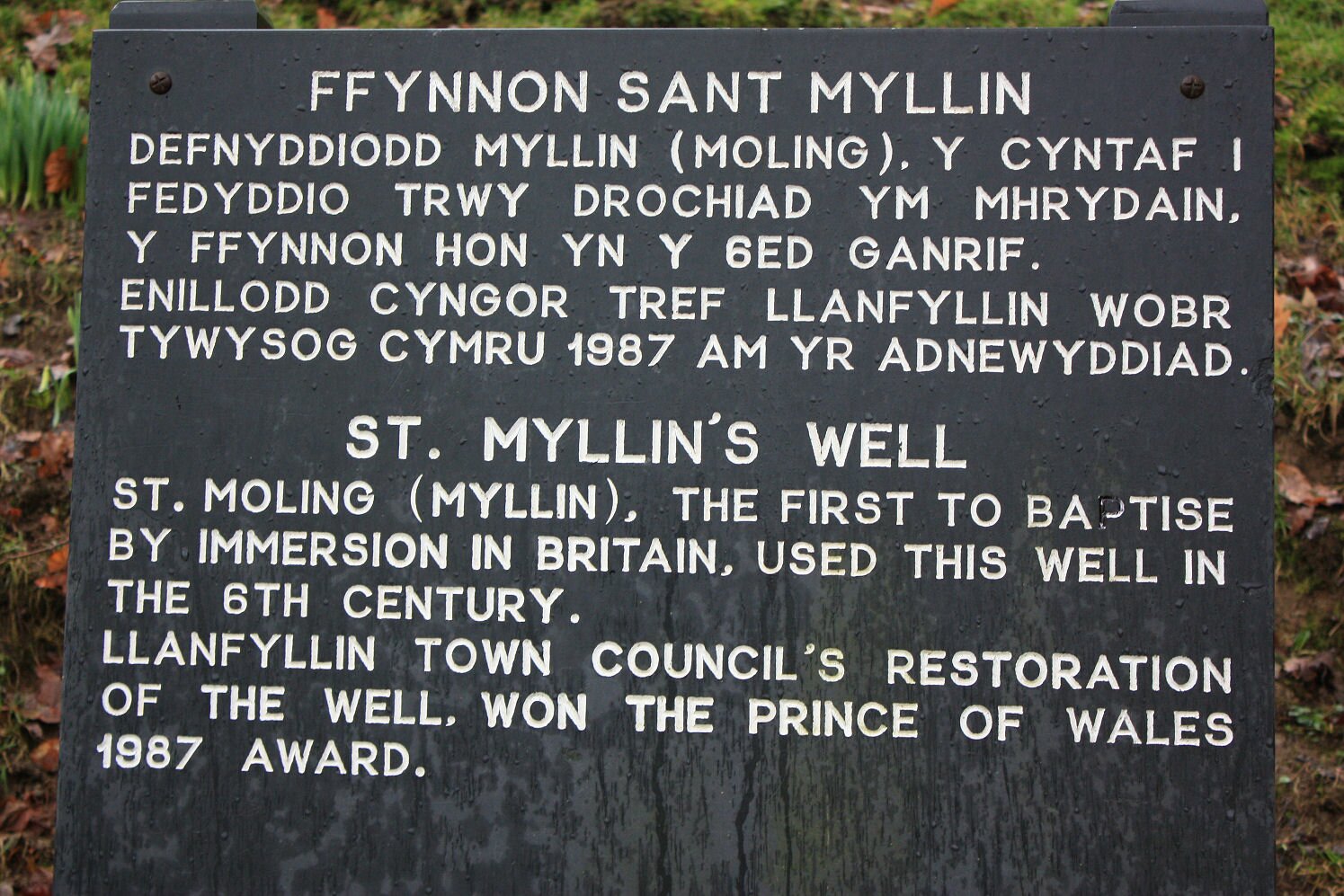
The teachings Gundulphus (also known as Gundulf) were examined by the Bishop of Cambray (Cambrai) and Arras, northern France, in the year 1025. Gundulphus was opposed to the doctrines of the Catholic church and taught against infant baptism, Because to an infant, that neither wills nor runs, that knows nothing of faith, is ignorant of its own salvation and welfare. Gundulphus it seems was a itinerant travelling evangelist who established and strengthened congregations of the Lords people throughout northern France and Belgium.
Sir Francis Walsingham (died 1590) says of John Wycliffe It was in the year 1381, that, that damnable heretic, John Wickliffe, reassumed the cursed opinions of Berengarius.
Today Berengarius is mainly remembered for his objection to the teaching of Transubstantiation. What is definitely not taught is his objection to the many other doctrines of the Roman church including that of infant baptism.
Between the years 999 & 1010 Berengarius was born at Tours, and was educated in the church being a pupil of Bishop Fulbert of Chartres (died 1028). By 1030 Berengarius was a cannon in the church of St. Martins, Tours. Berengarius became famous as a lecturer becoming head of the school at Tours. By 1040 he was archdeacon and by 1047 was treasurer of Angers cathedral. In 1047 he wrote a treaty against the Eucharist (denying material change in the elements) and was excommunicated by pope Leo 1X in 1050. Berengarius was not present and therefore unheard. In the years 1059 and 1079 Berengarius (under considerable pressure) yielded to Rome and subscribed to the doctrines he loathed.
It would seem that Berengarius was under the service and protection of Geoffrey Martel, Count of Anjou. Some time after 1060 Geoffrey the Bearded replaced Geoffrey Martel and Berengarius slowly fell out of favour, especially with his constant battles with the pope. After 1080 Berengarius retired to the hermitage of St. Come, on an island three miles west of Tours. Berengarius died a natural death in 1088. Whether he was excommunicated at the time of his death is unknown as well as to his relationship with the Roman Catholic church. Berengarius was one of the last opponents inside the Catholic church of what would become the new Catholic teaching on Transubstantiation.
In the previous century Rabanus Maurus and Ratramnus condemned the teaching of realism in the Eucharist, being taught by Paschasius Radbertus in the year 818 (their abbot, they were both at the same abbey) who was taking a step further towards Transubstantiation, in his book On the body and Blood of the Lord in which he pushed to extremes the teaching of John of Damascus (c.710). In John of Damascus book De Fide Orthodoxa a further step was taken towards the teaching of the real presence of the blood and Flesh of Christ in the Eucharist. This was being made over that of the symbolic presence. Although started beforehand the theory of Transubstantiation was slowly developing over three centuries from the eighth.
During the tenth century the theological arguments over the Eucharist did not become heated, but during the next century the pro-Transubstantiation party became quite dogmatic and won the day. Lanfrank (an Italian) later to be Archbishop of Canterbury, wrote a book against Berengarius during 1087 in Normandy.
Rabanus Maurus also wrote a book which was condemned in 1050 holding to the views of John Scotus (c.850 also known as John the Scot and Erigena). Berengarius was said to hold the same views but this has never been proved.
The term Transubstantiation was established by the Roman Catholic church by 1080 and proclaimed formerly as church doctrine by pope Innocent III in 1215.
It is said Berengarius preached the Gospel, and his followers who spread throughout Europe being nicknamed Berengarians. Berengarius was opposed to the baptism of infants which we learn from two witnesses, one Deodwinus, Bishop of Liege, who in 1035 who wrote to Henry 1 king of France complaining about Berengarius who was at that time, deacon of Angers and Bruno, who was the bishop. Both were said to have attempted a reformation of the doctrines of Rome, including the rejection of infant baptism and using the Bible as their only authority, rejecting Romish traditions.
The same complaints were repeated by Guitmund von Aversa (or Guitmond) a Roman Catholic writer in the 1080s who says that the doctrines of these two men had spread throughout France, Germany, Italy and England, in town, village and city, nobility and gentry were infected.
It has been suggested over the years by the Roman church that Berengarius was a heretic and various accusations made against him, but without the evidence. Evidence does suggest though that Berengarius did make an attempt to restore Bible teaching which would be felt for centuries to come.
Berengarius was followed later by Pierre de Bruis and Arnold of Brescia who were opposed to many Catholic teachings including infant baptism, the Mass, church buildings and altars (because any place is suitable for prayer and meeting), prayers for the dead, veneration of the cross, celibacy, good works and transubstantiation.
Pierre de Bruis was possibly a Priest who was certainly removed from office and began to preach in Dauphine and Provence, southern France. He seems to have been active from around 1100. His followers were known as Petrobusians, although they referred to themselves as Christians. They appealed for a return to the authority of the Scriptures and believers baptism quoting Go out into all the world, and preach the gospel to every creature: he that beliveth, and is baptised, shall be saved; but he that believeth not shall be damned also he is quoted as saying, But we await a time suitable to faith, and baptise a man, after he is ready to recognise God and to believe in Him, we do not, as you charge us, rebaptise him, because the man who has not been washed with the baptism by which sins are washed away ought never to be called baptised.
Peter de Bruis was able to preach for a while under the protection of Earl Hildephonus.
Bruis wrote of the Catholic Church - "It is said, That this Antichrist is not one single person, but a confederacy of iniquity in opposition to Christ, etc. This Contrariety of Antichrist to Christ consists in his worldly wisdom, his pharisaical religion, managing, spiritual power by secular tyranny, riches, dignity, etc. By filling up the Churches of Christ with worldlings; that the perfection of Antichrist consists in a full usurpation of the authority of Christ according to 2 Thess; That the work of Antichrist is to change truth into error and error into truth to rob Christ of His merits, placing sanctification of the spirit in externals and grace and salvation in the work done; neglecting discipline; by maintaining unity by tyranny; the subterfuges of Antichrist are laid open and its causes; The moving causes and scriptures loudly calling to come out from and not to touch her, etc". Quoted from Perin's history.
A Papal Bull (formal papal pronouncement) was made against preachers who were teaching doctrines contrary to the RC Church by Pope Urban 11 in 1096 and the second Lateran Council of 1139. As a result Bruis was burnt alive at St. Giles, near Nimes, southern France (about 50 miles from Marseille) by the local people infuriated by his teaching in 1140.
Pierre de Bruis is considered by Catholic and later Protestant historians as a heretic and it has been suggested by these historians that he rejected a large proportion of Scripture, against any evidence.
His associate Arnold of Bresia who tried to reform the RC Church was executed (by burning) under the authority of the prefect of Rome in 1152/5 and his ashes were thrown into the Tiber.
In 1118 Gregory Grimm of Ensisheim, France died after being tortured, because he had been baptised by his grandfather who in turn had been baptised (by immersion for the remission of sins) by a travelling merchant from Venetia who was from the only church of the saints. In 1143 a congregation of over 100 Christians was seized on the lower Rhein. Under torture they confessed that such congregations were everywhere but in concealment. Because there was no organised hierarchy (following the Biblical pattern) it was extremely difficult for the authorities to find congregations as each had its own Bishops and Deacons.
During the severe persecution that took place during the burning of many heretics across France and other parts of Europe, evangelists came to support the churches that were being forced out of existence, from the Balkans and in particular Bulgaria so that the term Bulgare became the equivalent of Heretic. Mutilation of the word Bougre is still used as an insult (sodomite) and found its way into middle English and continues today as the word Bugger. By 1146 Henry of Toulouse was preaching the same doctrine and evangelists were undertaking missionary work throughout Europe and into England.
In the year 1147, Bernard a Cistercian monk and abbot of Clareval wrote a letter to the Earl of St. Giles complaining that he was harbouring Henry of Toulouse, a heretick who practised believers baptism and denied Catholic teachings. He was also opposed to the clergy.
Bernard said in his letter The churches are without people, the people with out priests, the priests without honour, and Christians without Christ. The churches are no longer conceived holy, nor the sacraments sacred, nor are the festivals any more celebrated. Men die in their sins, souls are hurried away to the terrible tribunal, without penitence or communion, baptism is refused to infants, who thus are precluded from salvation.
It is said that Henry was a follower of Pierre de Bruis but from the evidence it seems that Christianity was very widespread in Europe.
Henry managed to avoid capture but was later arrested, and sent in chains to the bishop of Ostia, under whose orders he died.
Everinus wrote to Bernard in 1146 complaining of a sect who had rejected infant baptism in favour of Believers Baptism, they had formed a church of Christ separate and apart from the Catholic church. Their Elders offered to debate with the Catholic Church their beliefs in light of the teaching of the Scriptures. This was rejected and instead they were burnt at the stake and the congregation was destroyed. Bernard was involved in oppression against hereticks throughout Europe and many died under his instructions. Today he is revered as a saint in the Catholic church.
By 1080 much of France, Italy and England had been affected by the above teachings and it would seem that New Testament Christianity was being spread throughout England just 14 years after the Norman Conquest of England in 1066.
In fact in northern Italy in the valleys of Piedmont it would become a thorn to the Roman church for its heresy. The most famous preacher of these valleys was Peter Waldo (the merchant of Lyons) who was active from around 1173. It was from Waldo that the Waldensian (or Vaudois) church was given its name. The Vaudois were not a single sect, they had several different groups of differing opinions, some who were very close to Catholic teaching but others who rejected Catholic teaching for the Gospel. Rainerius, a Friar, in the year 1250 complained that certain Waldeneses were withholding their children from Baptism.
This French picture circa 1415 shows the expulsion of the 'Albigensians' from Carcassone in 1209. What is forgotten today is that the first crusades were against Christians who had separated from the Catholic Church in Europe.
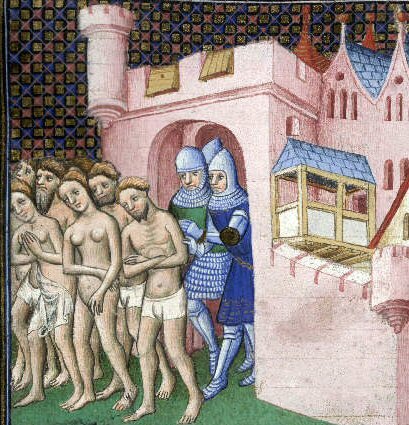
The Albigensian crusade, French picture 14th century. The excommunication of the Albigenses; the crusade against them.
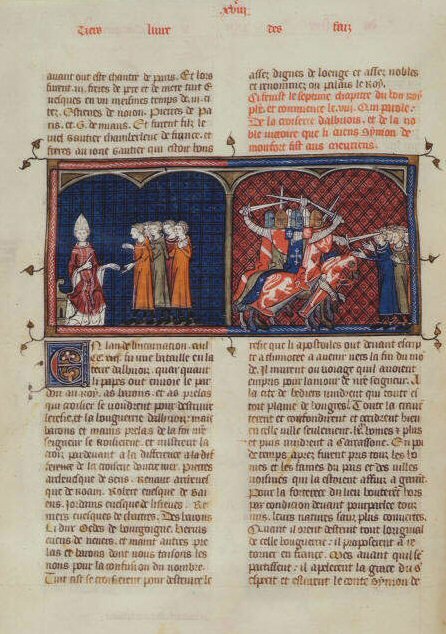
This French 14th century picture is of soldiers ransacking a house after the expulsion of it occupiers..
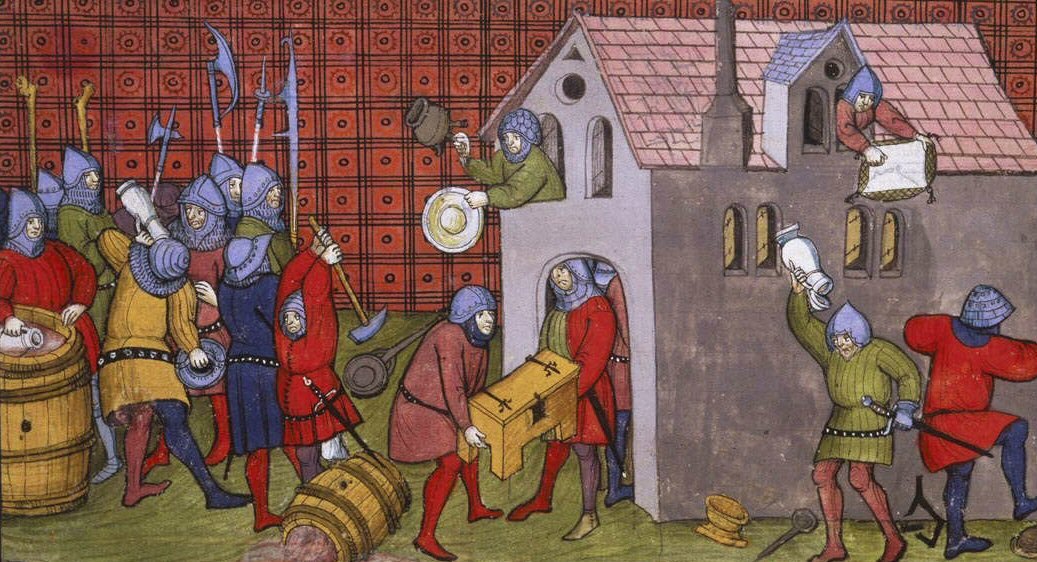
Next - the Gospel reaches Oxford